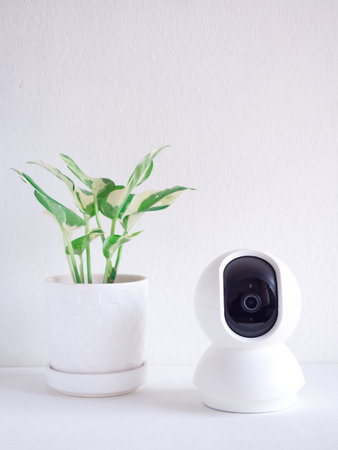Assess Your Home’s Security Needs
Before investing in a smart surveillance system, it’s crucial to first assess your home’s unique security requirements. Start by walking around your property and identifying any vulnerable areas—these might include front and back doors, ground-level windows, garage entrances, and dark corners of your yard. Each home is different, so take note of spots that could potentially attract unwanted attention.
Next, consider the overall safety of your neighborhood. Is your area prone to break-ins or vandalism? Are there recent incidents reported nearby? Local crime statistics can help you gauge the level of protection you might need. Additionally, think about what you want your surveillance system to accomplish. Do you want 24/7 monitoring, real-time alerts to your smartphone, or simply a deterrent presence?
| Area | Potential Risk | Recommended Coverage |
|---|---|---|
| Front Door | Package theft, unauthorized entry | Video doorbell, motion sensors |
| Backyard/Garage | Hidden access points, tool theft | Outdoor cameras with night vision |
| Windows (Ground Level) | Break-ins | Window sensors, indoor cameras facing windows |
| Driveway/Street View | Suspicious vehicles or individuals | Cameras with wide-angle lenses |
This initial assessment will give you a clear understanding of where to place cameras and what features you should prioritize when choosing your smart surveillance system. By tailoring your setup to your specific needs and environment, youll create a more secure and effective solution for protecting your home and loved ones.
2. Choose the Right Smart Cameras
Selecting the right smart cameras is a crucial step in setting up an effective home surveillance system. First, consider whether you need indoor cameras, outdoor cameras, or both. Indoor cameras are generally smaller and more discreet, while outdoor cameras are built to withstand weather conditions and often come with enhanced durability. Here’s a quick comparison:
| Camera Type | Best For | Weather Resistance | Installation Location |
|---|---|---|---|
| Indoor Camera | Monitoring inside rooms, entryways | No | Living room, nursery, hallway |
| Outdoor Camera | Securing yards, driveways, entrances | Yes (weatherproof) | Front door, backyard, garage |
Next, pay attention to video quality. For clear footage and easy identification, look for cameras that offer at least 1080p HD resolution. Some advanced models even provide 2K or 4K video for sharper details.
You’ll also want to consider power sources. There are typically three options: wired (constant power but requires installation), battery-powered (flexible placement but needs recharging), and plug-in (easy setup but may limit placement near outlets). Here’s a breakdown:
| Power Source | Pros | Cons |
|---|---|---|
| Wired | No recharging; consistent power | More complex installation; may require drilling |
| Battery-Powered | Flexible placement; no wires needed | Batteries need periodic charging/replacement |
| Plug-In | Easy installation; no batteries needed | Tied to nearby outlets; limited placement options |
Don’t forget about special features. Many American homeowners value motion detection—which alerts you when movement is detected—plus night vision for round-the-clock monitoring. Some smart cameras also offer two-way audio, allowing you to speak to visitors remotely via your smartphone app. Choose cameras with the features that best fit your security needs and lifestyle.
![]()
3. Integrate with Smart Home Devices
When setting up a smart surveillance system for your home, one of the most important steps is ensuring seamless integration with your existing smart home devices. Compatibility with leading platforms like Alexa, Google Home, and Apple HomeKit can significantly enhance your user experience by allowing centralized control and easy monitoring.
Why Integration Matters
Integrating your security cameras and sensors into your preferred smart home ecosystem provides several benefits. You can use voice commands to view live feeds, receive instant alerts on all connected devices, and even automate routines based on camera activity. For instance, you could program your lights to turn on automatically if motion is detected at night.
Popular Smart Home Ecosystems
| Platform | Main Features | Compatible Brands |
|---|---|---|
| Amazon Alexa | Voice control, routines, live feed display on Echo Show | Ring, Arlo, Blink, Wyze |
| Google Home | Integration with Google Assistant, Chromecast streaming, routines | Nest, Arlo, TP-Link Kasa, Eufy |
| Apple HomeKit | Siri control, automation through Home app, secure video storage in iCloud | Eve Cam, Logitech Circle View, Netatmo |
Tips for Smooth Integration:
- Check the compatibility list before purchasing new surveillance equipment.
- Use unified apps to manage all devices in one place for easier access and monitoring.
- Take advantage of automation features—set up custom alerts or actions when unusual activity is detected.
- Keep all firmware updated to maintain security and performance across your devices.
Selecting the right ecosystem and ensuring your surveillance devices are fully compatible will streamline your daily routine and bolster the overall security of your home.
4. Plan Camera Placement Strategically
Choosing the right locations for your smart surveillance cameras is essential for maximizing security and ensuring you stay within legal and ethical boundaries. Begin by identifying all entry points to your home, such as front and back doors, garage entrances, and accessible windows. These are critical spots that should always be monitored. Additionally, consider high-traffic areas like driveways, walkways, and common spaces where activity is frequent.
| Area | Reason to Monitor | Recommended Camera Type |
|---|---|---|
| Front Door | Main entry point; most burglaries start here | Video Doorbell or Outdoor Bullet Camera |
| Back Door/Garage | Common alternate entries for intruders | Outdoor Bullet or Dome Camera |
| Driveway/Yard | Monitor approaching vehicles or people | Wide-angle Outdoor Camera |
| Main Hallway/Living Room | High-traffic area inside the home | Indoor Dome or Pan-Tilt Camera |
While placing cameras, be mindful of privacy laws in your state and respect your neighbors’ boundaries. Avoid aiming cameras at areas where people have a reasonable expectation of privacy, such as inside neighboring homes or fenced-in yards. It’s also a good idea to post signage that alerts visitors about video recording for transparency and legal compliance. By thoughtfully planning your camera placement, you enhance security while maintaining respect for others privacy.
5. Set Up Remote Access and Notifications
One of the biggest advantages of a smart surveillance system is the ability to monitor your home from anywhere. To get started, download the manufacturer’s mobile app on your smartphone or tablet. Most leading brands like Ring, Arlo, and Nest offer free apps compatible with both iOS and Android devices.
Configure Mobile Apps for Remote Monitoring
After installing the app, follow the in-app instructions to link each camera to your account. Make sure your cameras are connected to Wi-Fi and have up-to-date firmware for seamless integration. Once set up, you can view live feeds from any location, whether youre at work or traveling out of state.
Enable Real-Time Alerts
Customize your notification settings within the app so you’re immediately alerted when motion is detected or someone rings your video doorbell. You can usually choose between push notifications, email alerts, or both. Some systems even allow you to create specific activity zones—like only receiving alerts for movement on your front porch rather than every car driving by on the street.
Sample Notification Features by Brand
| Brand | Alert Types | Activity Zone Customization | Mobile App Compatibility |
|---|---|---|---|
| Ring | Push, Email | Yes | iOS/Android |
| Nest | Push, Email | Yes | iOS/Android |
| Arlo | Push, Email, SMS | Yes | iOS/Android |
Cloud Storage for Video Footage
A secure cloud storage plan ensures that your video footage is saved offsite and protected against tampering or accidental deletion. Most smart surveillance brands offer tiered subscription services that store recorded clips for anywhere from a few days to several months. Check if your system supports local backups as well for added peace of mind.
Benefits of Cloud Storage:
- Secure Access: Only authorized users can view or download footage.
- No Risk of Physical Damage: Videos are protected even if cameras are stolen or damaged.
- Easy Sharing: Send clips to law enforcement or neighbors directly from your device.
6. Secure Your Network and Devices
Protecting your smart surveillance system from cyber threats is just as important as installing the cameras themselves. Hackers can exploit weak security measures to access your video feeds or even control your devices. To ensure your home remains safe, follow these essential steps:
Implement Strong Passwords
Always change default passwords on all your surveillance devices, including cameras and network recorders. Use complex combinations of uppercase and lowercase letters, numbers, and special characters. Consider using a password manager to keep track of your credentials securely.
Enable Encryption
Encryption helps protect the data transmitted between your cameras and your storage device or cloud service. Make sure your Wi-Fi router uses WPA3 encryption (or at least WPA2 if WPA3 isn’t available). Also, check that your surveillance devices support encrypted connections, such as HTTPS or SSL/TLS.
Regularly Update Firmware
Manufacturers often release firmware updates to patch security vulnerabilities or add new features. Check for updates regularly on both your cameras and network equipment, applying patches promptly to reduce the risk of exploitation.
Best Practices for Securing Your Smart Surveillance System
| Action | Description |
|---|---|
| Change Default Passwords | Create unique, strong passwords for each device. |
| Enable Two-Factor Authentication (2FA) | Add an extra layer of security where available. |
| Use Encrypted Connections | Select HTTPS or SSL-enabled devices and services. |
| Update Firmware Regularly | Check for manufacturer updates at least once a month. |
| Segment Your Network | Create a separate Wi-Fi network for smart home devices. |
Pro Tip
If you use cloud storage for video recordings, review the provider’s security policies and enable account alerts for suspicious activities. By following these steps, you’ll greatly reduce the chances of unauthorized access to your home surveillance footage.
7. Maintain and Upgrade Your System
Keeping your smart surveillance system in top shape is crucial for ongoing home security. Regular maintenance ensures your cameras work reliably, deliver clear footage, and keep up with the latest technological advances. Here’s how to make sure your system remains effective as your needs evolve:
Routine Maintenance Tasks
| Task | Frequency | Why It Matters |
|---|---|---|
| Check Camera Functionality | Monthly | Ensures all devices are online and recording properly. |
| Clean Camera Lenses | Every 1-2 months | Prevents dust or smudges from blurring footage. |
| Review Footage Storage | Quarterly | Avoids overwriting important recordings and confirms backup reliability. |
| Update Firmware/Software | As updates are released | Keeps your system secure and compatible with new features. |
| Test Alarm/Siren Features | Semi-annually | Makes sure alert systems will activate during emergencies. |
Upgrading as Your Lifestyle Changes
Your security needs may change over time—perhaps you’ve renovated your home, added a backyard pool, or started working remotely. Stay proactive by:
- Adding New Cameras: Cover new areas of your property or upgrade to higher-resolution models for better clarity.
- Integrating Smart Home Devices: Sync with doorbell cameras, smart locks, or voice assistants for enhanced control.
- Expanding Storage: Consider cloud subscriptions or local storage upgrades if you’re recording more footage than before.
- Exploring New Features: Look for AI-based alerts, facial recognition, or package detection as they become available.
Pro Tip:
If you’re unsure about upgrades or technical troubleshooting, many U.S.-based retailers offer professional support services either in-store or via appointment. Investing in regular checkups ensures your surveillance system keeps up with both technological advancements and changes in your household.


